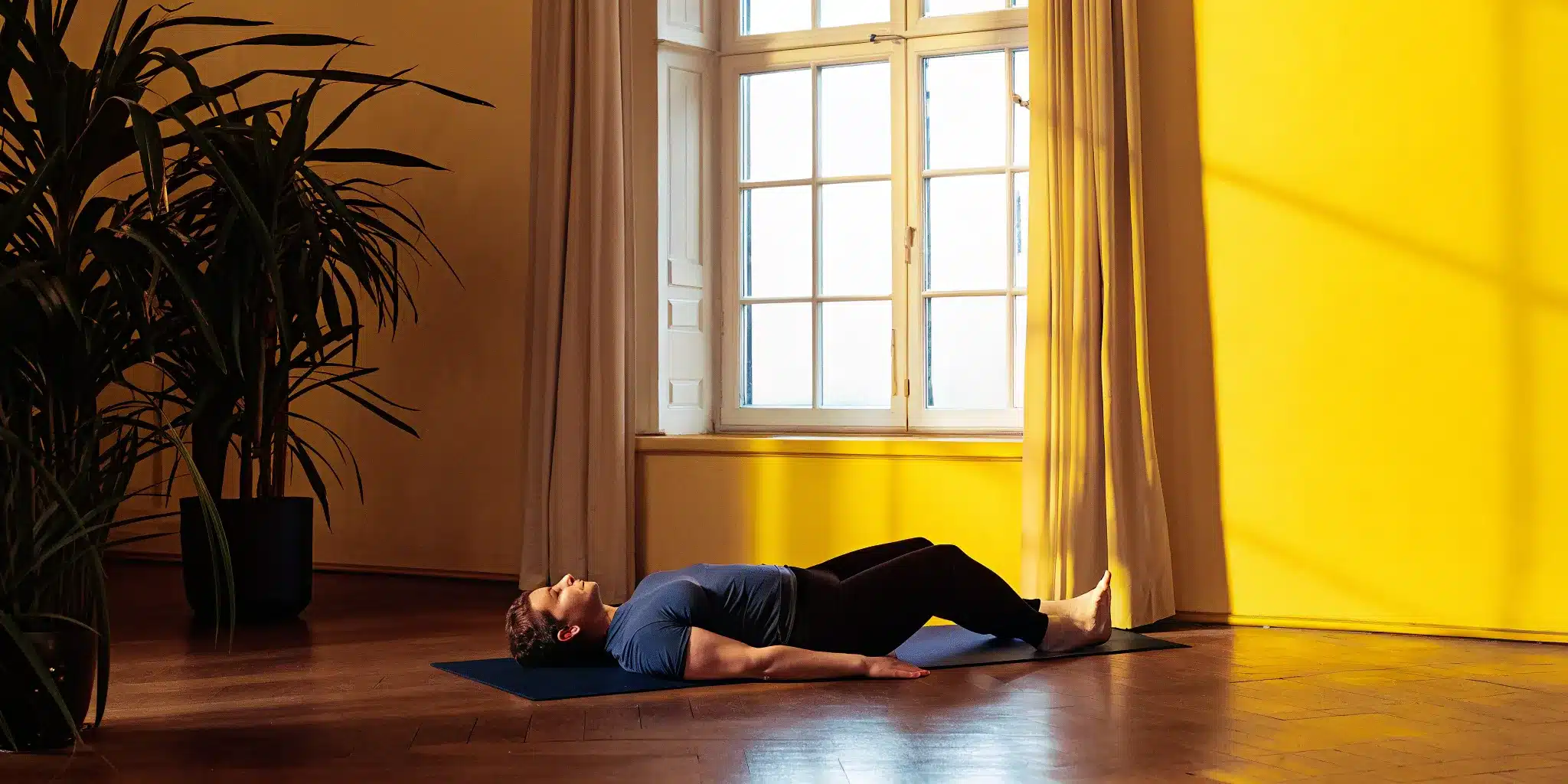If your first thought upon waking is about your aching back, it’s time for a new morning ritual. That familiar stiffness can put a damper on your entire day before it even really begins, making simple tasks feel like a chore. The good news is that finding relief doesn’t require a huge time commitment or any special equipment. You can start feeling better with a few simple movements you can do right in your bed. This guide is designed to walk you through the most effective morning stretches for lower back pain, helping you gently release tension, improve your mobility, and build a sustainable habit that supports a healthier, more comfortable back for the long haul. Let’s get you moving with more comfort and confidence.
Key Takeaways
- A Gentle Morning Stretch is Your First Line of Defense: Morning back pain often stems from hours of inactivity. A simple five-minute routine can wake up your muscles, release overnight tension, and set the stage for a more mobile day.
- Prioritize Proper Form Over Intensity: The goal is to feel a gentle release, not pain. Move slowly, breathe deeply, hold each position for 20-30 seconds, and listen to your body—if something hurts, ease up.
- Support Your Spine All Day Long: Your morning routine works best when combined with other healthy habits. Pay attention to your sleep position and daily posture, and don’t hesitate to see a doctor for pain that is severe or doesn’t improve.
Why Does Your Back Hurt in the Morning?
Waking up with an aching back is a frustrating way to start the day. Instead of feeling rested, you feel stiff, sore, and older than you are. If this sounds familiar, you’re not alone. Morning back pain is incredibly common, but that doesn’t mean you have to accept it as a normal part of your routine. Understanding the root causes is the first step toward finding relief and starting your day feeling refreshed and mobile.
Often, the discomfort you feel is a result of what happened the day before combined with hours of inactivity overnight. Your sleeping position, mattress quality, and even daily habits like sitting for long periods can all contribute. Think of it as a perfect storm of minor stresses that accumulate while you sleep, leaving you to deal with the aftermath when your alarm goes off. The good news is that you have the power to change this pattern. By incorporating a few simple adjustments into your life, starting with a gentle morning stretch routine, you can make a world of difference in how you feel each day. Let’s look at the specific reasons why your back feels this way and explore how targeted stretching can help you move with ease.
What Causes Morning Back Pain?
Morning back pain can stem from a few different sources. Often, it’s related to your sleeping environment. An unsupportive mattress or sleeping in an awkward position can strain your spine, leading to inflammation and pain by morning. Your daily activities also play a significant role. If you spend most of your day sitting at a desk or performing repetitive movements, certain muscles can become tight and overworked, while others grow weak. This imbalance can create tension that you feel most acutely after a long period of rest. In some cases, an underlying health condition could be the cause, but for many people, morning back pain is a lifestyle issue that can be managed with the right approach.
Why You Feel Stiff When You Wake Up
That stiff, locked-up feeling you have when you first get out of bed is a common experience. During the night, your body stays in one position for hours, which can cause your muscles and connective tissues to tighten up. While you sleep, there’s also less blood flow to your muscles, and the fluid that lubricates your joints can become thicker. This combination leads to the morning stiffness that makes those first few steps so challenging. Think of it like a car engine on a cold day—it needs a moment to warm up before it can run smoothly. Gentle movement is the key to loosening those stiff muscles and getting your body ready for the day.
How Stretching Eases Lower Back Pain
Stretching is one of the most effective ways to address morning back pain and stiffness. When you stretch, you encourage blood flow to your muscles, which delivers the oxygen and nutrients they need to function properly. This helps release the tension that built up overnight and improves your flexibility. A consistent stretching routine does more than just provide temporary relief; it helps prevent future pain by strengthening your back and the core muscles that support it. While stretching isn’t a cure-all for every type of back issue, it’s a powerful tool for maintaining a healthy, flexible spine and reducing the tightness that contributes to morning discomfort.
7 Gentle Stretches to Relieve Morning Back Pain
Waking up with a stiff, achy back can put a damper on your entire day. Before you even think about swinging your legs out of bed, your back is already protesting. The good news is that you can ease into your morning with a few simple movements designed to gently wake up your spine and relieve that all-too-familiar tension. Think of it as a quiet conversation with your body before the day’s demands begin.
This simple routine focuses on gentle stretches that lengthen your spine, increase blood flow to your back muscles, and improve your overall mobility. You can do most of these right in your bed. The key is to move slowly and mindfully, paying close attention to how your body feels. There’s no need to push or force anything; the goal is gentle relief, not an intense workout. By incorporating these back-friendly exercises into your morning, you can start your day with less pain and more freedom of movement.
1. Knee-to-Chest Stretch
This is a fantastic stretch to start with because it’s incredibly gentle on the lower back. It helps lengthen the spine and release tension that may have built up overnight.
Lie on your back with your knees bent and your feet flat on the bed. Take a deep breath in. As you exhale, slowly pull one knee toward your chest, holding it with both hands. Keep your lower back pressed gently into the mattress. Hold this position for about 20 to 30 seconds, breathing steadily. Release and repeat with the other leg. For a deeper stretch, you can then bring both knees to your chest at the same time.
2. Cat-Cow Movement
The Cat-Cow movement is a classic for a reason. It’s a dynamic stretch that warms up the spine and improves flexibility by moving it through both flexion and extension.
Start on your hands and knees in a tabletop position, with your wrists directly under your shoulders and your knees under your hips. As you inhale, drop your belly toward the bed, lift your chest, and look forward (this is Cow Pose). As you exhale, round your spine up toward the ceiling, tucking your chin to your chest (this is Cat Pose). Flow between these two movements for about a minute, letting your breath guide the motion.
3. Child’s Pose
Child’s Pose is a restorative stretch that feels amazing on a tight lower back. It provides a gentle stretch for your entire back, along with your hips and shoulders.
From your hands and knees, spread your knees wide apart while keeping your big toes touching. Sit your hips back toward your heels and fold forward, resting your forehead on the bed or a pillow. Reach your arms out in front of you or rest them alongside your body. Breathe deeply into your back, feeling it expand with each inhale. Hold this pose for 30 seconds to a minute, just letting your body relax and release.
4. Pelvic Tilt
This is a very subtle but powerful movement for waking up the core muscles that support your lower back. A strong core is essential for maintaining a healthy spine.
Lie on your back with your knees bent and feet flat on the bed, arms resting by your sides. Take a gentle breath in. As you exhale, engage your abdominal muscles to gently press your lower back into the mattress, slightly tilting your pelvis upward. This is a small, controlled movement—you’re not lifting your hips off the bed. Hold for a few seconds, then release as you inhale. Repeat this 10 to 15 times.
5. Supine Twist
A gentle twist is a great way to increase spinal mobility and stretch the muscles along the sides of your back and hips.
Lie on your back and bring your knees toward your chest. Extend your arms out to the sides in a “T” shape. As you exhale, slowly lower both knees to one side, keeping both shoulders as close to the bed as possible. You can turn your head to look in the opposite direction for a deeper stretch through your neck. Hold for 20 to 30 seconds, then use your core muscles to bring your knees back to the center and repeat on the other side.
6. Sphinx Pose
The Sphinx Pose is a gentle backbend that helps counteract the forward-flexed posture many of us have from sitting or sleeping curled up. It encourages the natural curve of your lower spine.
Lie on your stomach and prop yourself up on your forearms, placing your elbows directly under your shoulders. Keep your palms flat on the bed. Gently press down through your forearms and palms to lift your head and chest, creating a mild backbend. Keep your hips pressed into the bed and look straight ahead to avoid straining your neck. Hold for about 30 seconds, breathing comfortably. This is one of the most effective morning stretches for back pain.
7. Modified Cobra
Similar to the Sphinx Pose, the Modified Cobra is another gentle backbend that helps strengthen your back muscles and open up your chest.
Lie on your stomach with your forehead resting on the bed. Place your hands under your shoulders with your elbows tucked in close to your body. On an inhale, gently lift your head and chest off the bed, keeping your lower ribs on the surface. Keep your hips on the bed and a slight bend in your elbows. Only lift as high as you can without feeling any pinching in your lower back. Hold for 15 to 20 seconds, then slowly lower yourself back down.
How to Build Your Morning Stretch Routine
Knowing which stretches to do is only half the battle. The other half is creating a routine that feels good, keeps you safe, and becomes a natural part of your day. When you approach stretching with intention, you set yourself up for long-term success and relief. Think of it as a quiet conversation with your body each morning—a chance to check in and give your muscles the gentle wake-up call they need.
Building this habit doesn’t have to be complicated. The key is to focus on a few core principles: safety, proper form, consistency, and listening to what your body tells you. By integrating these simple guidelines, you can transform a few minutes of stretching into a powerful tool for managing back pain and improving how you move all day long. Let’s walk through how to create a routine that works for you.
Start Your Routine Safely
Before you begin any new exercise plan, it’s always a good idea to check in with your doctor, especially if you’re dealing with a specific injury or significant chronic pain. A healthcare professional can help you understand your body’s unique needs and confirm which movements are best for you. Your safety is the top priority, and getting expert advice ensures you can start your stretching journey with confidence. Think of it as laying a solid foundation for a healthy, sustainable habit that will support your back for years to come.
Focus on Proper Form and Breathing
When you’re stretching, aim for smooth, gentle movements rather than sudden or jerky ones. The goal is to ease your muscles into a stretch, not force them. Pay close attention to your breath—it’s one of the best tools you have. Inhale as you prepare for a movement and exhale as you deepen into the stretch. This helps relax your nervous system and allows your muscles to release more effectively. Most importantly, listen to your body. A stretch should create a feeling of gentle tension, not sharp pain. If you feel any pinching or strain, ease up immediately.
How Long Should You Hold Each Stretch?
To get the most out of your morning routine, timing is important. For most static stretches, aim to hold the position for about 20 to 30 seconds. This gives your muscle fibers enough time to relax and lengthen, which is what helps improve your flexibility and relieve stiffness. Rushing through the hold won’t give you the same benefits. Remember to breathe steadily throughout the entire duration. If a stretch involves both sides of your body, like the Knee-to-Chest or Supine Twist, make sure you hold it for 20 to 30 seconds on each side to maintain balance.
Make Stretching a Daily Habit
Consistency is what truly makes a difference in managing lower back pain. Just a few minutes of stretching each morning can have a cumulative effect, helping to keep your muscles flexible and your spine supported. To build a lasting habit, try linking your new routine to something you already do every morning, like right after you get out of bed or while your coffee is brewing. It doesn’t have to be a long session—even five minutes a day is better than a longer session once a week. Soon, it will feel like a natural and necessary part of starting your day.
Stretch Safely: Guidelines and Modifications
Starting a new stretching routine is a fantastic step toward feeling better, but safety should always come first. The goal is to relieve pain and increase mobility, not create new problems. Moving with awareness and understanding your body’s signals are key to a successful and sustainable practice. These guidelines will help you stretch effectively while protecting your back from further strain.
Listen to Your Body
You are the ultimate expert on your own body. Before you begin any new exercise program, it’s always a good idea to talk with your doctor, especially if you’re dealing with a specific injury or significant pain. As you move through each stretch, focus on gentle, fluid motions. Avoid any sudden or jerky movements, which can put unnecessary stress on your muscles and spine. The idea is to ease into the stretch, not force it. Your body will tell you what it needs and what feels good—your job is to pay close attention and honor those signals.
Adapt Stretches for Your Needs
Not every stretch is right for every person, and that’s perfectly okay. If a particular movement doesn’t feel good or seems to make your pain worse, don’t push through it. You can try modifying the pose to reduce its intensity or simply skip it and move on to one that feels better. If you find that even gentle stretching consistently aggravates your back, it’s a clear sign to stop and consult a healthcare professional. Persistent pain might indicate an underlying issue that needs a proper diagnosis, and a doctor can help determine the best path forward for you.
Know When to Stop Stretching
Understanding the difference between a productive stretch and a painful one is crucial. A good stretch should create a feeling of mild to moderate tension in the muscle—a gentle pull, but never a sharp or stabbing sensation. If you feel any sharp, shooting, or increasing pain, stop the stretch immediately. Pushing your body into a position of pain is counterproductive and can easily lead to injury. Remember, the motto here is “no pain, no pain.” The aim is to release tension and create space in your body, not to endure discomfort.
When It’s Best to Skip Your Routine
There will be days when stretching isn’t the best choice, and recognizing those times is a sign of strength, not weakness. If your back pain is severe, feels worse than usual, or simply isn’t improving with gentle movement, it’s time to take a break. Forcing your body to stretch when it’s in distress can do more harm than good. In these cases, it’s best to rest and consult a healthcare provider for a proper diagnosis and personalized guidance. Listening to your body’s warning signs will help you build a healthier, more effective long-term routine.
Support Your Back Beyond Your Morning Routine
A great morning stretch routine is a fantastic first step, but what you do for the rest of the day matters just as much. Think of your morning stretches as the warm-up for a day of supporting your spine. By paying attention to how you sleep, sit, and move, you can build a strong foundation for a healthy, pain-free back. It’s about creating small, consistent habits that work together to keep you feeling mobile and comfortable from morning to night.
Making a few simple adjustments to your daily life can reinforce the benefits of your morning routine. It helps prevent the tension and stiffness from creeping back in, ensuring the relief you feel after stretching lasts longer. Let’s look at a few key areas where you can give your back some extra support.
Tips for a Better Sleep Position
You spend about a third of your life in bed, so your sleeping position has a huge impact on how your back feels when you wake up. If you’re a back sleeper, try placing a pillow under your knees to maintain the natural curve of your lower spine. For side sleepers, putting a pillow between your knees can prevent your upper leg from pulling your spine out of alignment. While it can be a tough habit to break, try to avoid sleeping on your stomach, as it can strain your neck and back. These small changes can help you wake up with less stiffness and more ease.
Improve Your Daily Posture
Whether you’re at a desk or on your feet, your posture plays a leading role in back health. Slouching can put a lot of stress on your lower back. Try to sit with your feet flat on the floor and your back straight against your chair. Get up and walk around every 30 minutes to give your muscles a break. Regular stretching is one of the best ways to improve your posture, as it helps relieve muscle tension and makes it easier to hold your spine in a healthy alignment. It’s a myth that you should stop moving when your back hurts; gentle activity often helps you feel better and prevents pain from returning.
Complementary Activities for a Healthy Back
Keeping your body in motion is essential for a healthy back. Beyond your morning stretches, incorporating low-impact activities into your week can make a big difference. Things like walking, swimming, or gentle yoga help strengthen the muscles that support your spine without putting excess strain on them. Even a short, 15-minute routine of back exercises can help keep your back flexible and prepared for the day. The goal is to build a consistent habit of movement that supports your spine and helps prevent stiffness and injury.
Important Considerations Before You Start
Before you jump into a new stretching routine, it’s smart to pause and consider your unique circumstances. While the stretches we’ve covered are gentle, everyone’s body is different. Your health history, current fitness level, and life stage all play a role in what feels good and what’s safe for you. Taking a moment to think about these factors helps you create a routine that truly supports your body and prevents injury, ensuring your path to a pain-free back is a smooth one.
Stretching with High-Risk Conditions
If you’re dealing with a significant injury or a chronic health condition, it’s essential to get a professional opinion first. Pushing through sharp pain is never a good idea, and certain movements could make an underlying issue worse. Always talk to a doctor before starting new exercises, especially if you have a pre-existing condition. A healthcare provider can help you understand your body’s specific limitations and needs, giving you the confidence to move forward safely. Their guidance ensures that your stretching routine will help you heal, not cause further harm.
Modifications for Different Life Stages
Our bodies are constantly changing, and the way we stretch should adapt, too. The needs of a 25-year-old desk worker are different from those of a 65-year-old retiree. The good news is that many effective stretches don’t require special equipment and can be easily modified. For older adults or those new to exercise, the focus might be on gentle movements that maintain mobility. For others, the goal might be to counteract the effects of sitting all day. The key is to choose stretches that feel right for your body right now and adjust as your needs evolve.
Guidelines for Stretching During Pregnancy
Pregnancy brings incredible changes to the body, and lower back pain is a common companion. Gentle stretching can offer wonderful relief, but it’s crucial to be extra mindful during this time. Your ligaments are looser, and your center of gravity is shifting, which can make you more prone to injury. If a stretch makes your back pain worse or you feel any new or sharp pain, it’s time to stop and consult your doctor. Prioritizing safety ensures that both you and your baby stay healthy while you manage pregnancy-related aches.
What to Know About Post-Surgery Care
Recovering from surgery or a major back injury requires a careful and considered approach. Your body is in a delicate healing phase, and the wrong movements could cause a serious setback. This is a time when professional guidance is non-negotiable. If you’ve had a back injury or are recovering from a procedure, it’s vital to talk to a physical therapist or your doctor before starting any new exercise program. They can create a personalized plan that supports your recovery, helping you regain strength and flexibility without compromising the healing process.
When to Work with a Professional
While a consistent morning stretch routine can work wonders, it’s not a cure-all for every type of back pain. Sometimes, your body needs a more targeted approach, and that’s when it’s time to call in a professional. Think of it as adding an expert to your wellness team. Pushing through certain kinds of pain can do more harm than good, so learning to recognize when you need support is a crucial part of caring for your back.
Working with a professional doesn’t mean you’ve failed at managing your pain alone. It means you’re taking a proactive and informed step toward feeling better. A specialist can provide a proper diagnosis, create a personalized treatment plan, and guide you through exercises that are safe and effective for your specific situation. This expert guidance can help you get to the root of the problem and build a stronger, more resilient back for the long term.
Signs You Should Seek Help
It’s important to listen to your body’s signals. If your back pain is severe, doesn’t improve after a week or two of gentle stretching, or actually gets worse when you stretch, it’s time to consult a healthcare provider. You should also seek professional help if the pain is accompanied by numbness, tingling, or weakness in your legs, or if you’re experiencing issues with bladder or bowel control. These can be signs of a more serious issue that requires a medical diagnosis. Remember, the goal is to feel better, and if your efforts aren’t leading you in that direction, a professional can help steer you back on course.
How to Find the Right Specialist
Your primary care doctor is a great starting point. They can assess your symptoms and help determine the cause of your pain. From there, they might refer you to a specialist like a physical therapist, who can design a program of specific exercises and stretches for you. It’s always a good idea to talk to a doctor before starting any new exercise program, especially if you have a pre-existing injury or are dealing with significant pain. They can ensure the movements you’re doing are safe and beneficial for your body’s unique needs.
Questions to Ask Your Provider
To make the most of your appointment, go in with a few questions prepared. Ask what they believe is causing your pain and what you can do at home to manage it. It’s helpful to inquire about which specific activities or stretches you should do and which you should avoid. You can also ask if any diagnostic tests, like an X-ray or MRI, might be necessary to get a clearer picture of what’s going on. Getting answers to these questions will empower you with a clear, actionable plan for moving forward and finding lasting relief.
Create a Long-Term Plan for a Healthy Back
Finding relief from morning back pain is a great first step, but keeping that pain from coming back is the real goal. Think of your morning stretches as the foundation of a long-term strategy for a healthier, more resilient back. It’s about shifting from reacting to pain to proactively caring for your body. Consistency is what transforms these simple movements into a powerful tool for maintaining mobility and preventing future issues.
A long-term plan doesn’t have to be complicated. It’s about creating sustainable habits that support your spine throughout the day, not just for ten minutes in the morning. By committing to a routine, you’re investing in your future self—one who can move with more ease and confidence. This approach empowers you to understand your body’s needs and build a lifestyle that keeps your back strong and flexible for years to come. It’s about playing the long game for your health. This section will guide you through creating a simple, sustainable plan that fits into your life. We’ll cover how to build a routine you can actually stick with, use stretching to prevent future pain, and track your progress in a meaningful way.
Build a Routine You Can Stick With
The most effective stretching routine is the one you do consistently. Don’t worry about creating the perfect, hour-long session right away. Instead, focus on what’s realistic for you. Starting with just five minutes each morning is a fantastic goal. You can link this new habit to something you already do, like stretching while your coffee brews. Doing these stretches daily can keep your back flexible and ready for the day. Start slow and gradually increase the intensity or duration as your body adjusts. The key is to build momentum. If you miss a day, don’t sweat it. Just pick it back up the next morning. The goal is progress, not perfection.
Strategies to Prevent Future Pain
A consistent morning stretching routine does more than just ease current aches; it helps keep your muscles flexible and supports your spine. Think of it as daily maintenance for your body. Over time, this simple habit can significantly improve your posture, making it easier to sit and stand correctly throughout the day. Daily stretching also reduces the chronic muscle tension that often leads to pain and stiffness. By keeping your muscles pliable and ready for movement, you lower your risk of tweaks and injuries from everyday activities. This proactive approach is one of the best strategies for ensuring your back stays healthy and pain-free in the long run.
How to Track Your Progress
Progress isn’t always measured by big leaps; it’s often found in small, everyday improvements. Pay attention to how your body feels. Can you bend down to tie your shoes with a little more ease? Do you feel less stiff when you first get out of bed? These are the signs that your routine is working. You might even consider keeping a simple journal to note how you feel each day. Aim to do these stretches daily to maintain flexibility and mobility. Most importantly, always listen to your body. If a stretch makes your pain worse, or if you have ongoing discomfort, it’s a signal to stop. When in doubt, it’s always best to see a doctor to get a proper diagnosis and personalized advice.
Related Articles
- Stretch 3 Times a Day? Benefits & Safety Guide – STRETCHMED
- 10 Benefits of Stretching: Feel & Move Better – STRETCHMED
- How to Improve Mobility After 60: A Complete Guide – STRETCHMED
Frequently Asked Questions
How soon can I expect to feel relief from my morning back pain? You’ll likely feel an immediate difference in stiffness right after your first session. That initial feeling of loosening up is a great start. However, for a noticeable reduction in your daily morning pain, consistency is the key. Stick with the routine for a couple of weeks, and you should start to see a real change as your muscles become more flexible and your spine gets the regular support it needs.
Is it better to stretch on the bed or on the floor? When you’re just starting, doing these gentle stretches in bed is perfectly fine. It’s a comfortable and accessible way to ease into the movements. As you become more familiar with the routine, you might find that moving to a yoga mat on the floor provides a firmer, more stable surface, which can help you maintain better form and get a slightly deeper stretch.
What if I can’t do one of the stretches because it’s uncomfortable? That’s completely okay, and it’s important to listen to that signal from your body. This routine is a template, not a strict set of rules. If a particular stretch causes any sharp or pinching pain, simply skip it. You can still get tremendous benefits from the other movements. The goal is always gentle relief, not forcing your body into a position that hurts.
Can I do this stretching routine at night instead of in the morning? Absolutely. While this routine is designed to combat morning stiffness, stretching before bed is also fantastic. It can help release the tension built up throughout the day and may even help you sleep better. The most important thing is creating a consistent habit, so choose the time of day that you’re most likely to stick with.
Will stretching still help if my mattress is the main problem? Yes, it will definitely help manage the symptoms. Stretching can counteract the stiffness and soreness caused by an unsupportive mattress. However, think of it as a powerful management tool rather than a complete fix. For long-term relief, it’s wise to also address the root cause by investing in a mattress that properly supports your spine.








